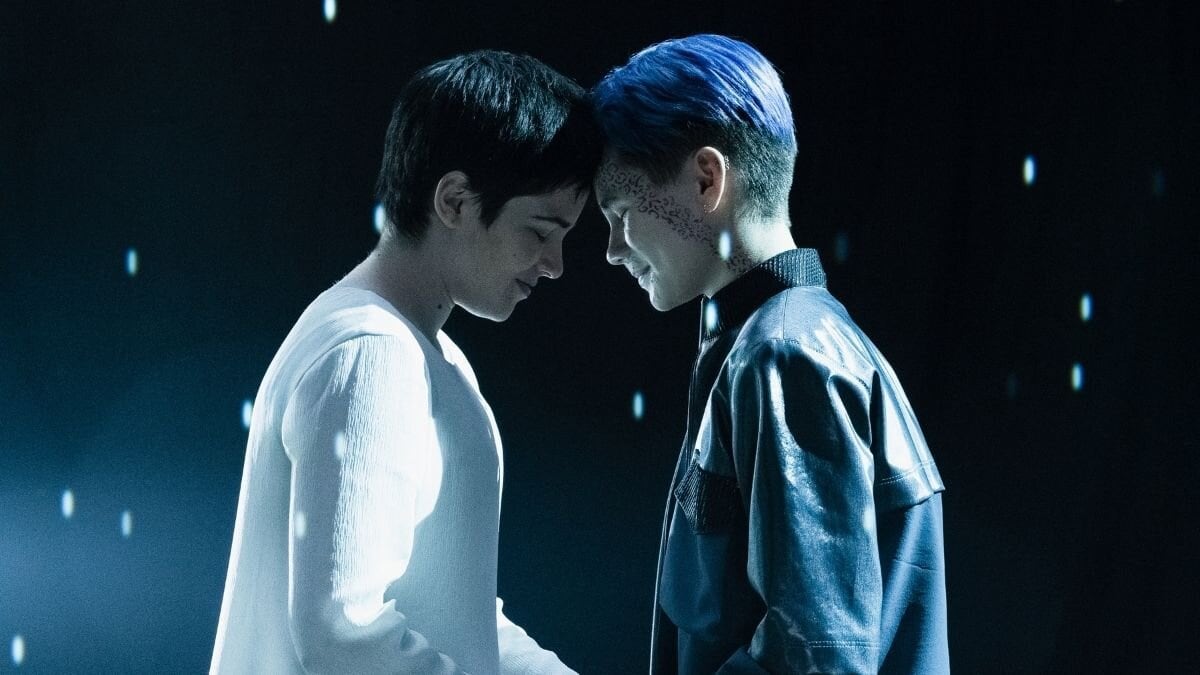This post contains spoilers for the Star Trek: Discovery Season 3 finale.
As Star Trek: Discovery ended its third season Thursday, Starfleet medical officer Hugh Culber (Wilson Cruz) made a big promise to Gray, a young deceased Trill boy who still appears to his partner, Adira. “We’ll help you to be seen,” Culber said. “Truly seen.”
Gray and Adira became historic additions to the Discovery cast last year as the first explicitly trans and nonbinary characters in the franchise’s history. Gray joined with a symbiont shortly before his death, linking him with all of its past hosts stretching back generations. When he died, Adira became the first human to successfully host a symbiont—linking them with those same hosts, including Gray.
As these characters’ journeys have unfolded, their identities have enriched, but never defined, their stories—a detail both Blu del Barrio, who made their TV debut as Adira, and Ian Alexander, the OA alum who plays Gray, have both appreciated. (Both actors are nonbinary; while del Barrio uses “they/them” pronouns, Alexander uses “he/him” and “they/them” pronouns interchangeably.) The Daily Beast spoke with the two recently ahead of the finale about making history within the franchise, filming that gorgeous finale set inside a hologram, and what lies ahead in Season 4.
Alexander and del Barrio met, as the latter recalled, right around the time production had finished filming this season’s third installment. Both actors remember forming an instant bond on set. “I remember meeting them and sort of instantly—like, immediately—knowing that we were going to be friends right away,” Alexander said. “Our energies seemed very similar. Our style was even very similar. We were literally wearing like basically the same exact outfit.”
Del Barrio framed it another way: “We’re both pretty nervous people,” they said with a laugh. “We can be pretty anxious people.”
Neither Alexander nor del Barrio was a diehard Trekkie before they joined Discovery—although Alexander notes that their parents are big fans, and own several box sets. Their father even decorates their Christmas tree every year with ornaments shaped like spacecraft from both Star Trek and Star Wars. (“’Cause, you know, it’s a dual household.”) Del Barrio, meanwhile, began to dig into the lore as fans reached out to tell them exactly where to start—“which episodes talk about Trill, which branches of the series go where... So now, now I feel a lot more well-versed than I had before.”
Both actors felt the typical blend of nervousness and excitement as they began their new roles—and both found support and comfort in the relationships they built on set. “We really leaned on each other a lot,” Alexander said of their early days performing with del Barrio. “I think we really helped each other feel a lot less alone and feel a lot more validated, and just seen and understood.”

Blu del Barrio as Adira in Star Trek: Discovery.
CBSThe pressure of joining a decades-long franchise like Star Trek as a young performer is pretty self-evident—but del Barrio faced an added layer of anxiety. They had only recently come out when they took the role—and suddenly, they had begun to meet a lot of new people. But as impostor syndrome began to creep in, they, too, found support on set from costars.
“Wilson [Cruz] and Anthony [Rapp] and Ian and everybody, really... immediately just wanted to help and support me, and be a friend and be an ally,” del Barrio said. “And I had Adira right in front of me, who really just allowed me to kind of explore more for myself what feeling comfortable felt like.”
Both Alexander and del Barrio had a hand in helping shape their characters to ensure that both seemed authentic. Alexander recalls speaking with writer Michelle Paradise and also Nick Adams, director of trans representation for GLAAD, throughout the creative process. They even offered some ideas for Season 4—specifically, styling. (Chief question: “Can we keep the mullet?”) The production also asked del Barrio how they wanted to approach Adira’s gender, and they recall speaking with directors throughout the season to impart what they recognized was a self-assured character with the believable self-doubt of a real teenager.
“They are very confident,” del Barrio said of Adira, “because that’s how they were brought to me—as someone who is wise beyond their years.” Still, they said, “I did want to bring in aspects of, yes, but they are 16, and they also might have a bit of anxiety about the situation they're in.”
It’s striking that Discovery opted not to disclose either character’s identity right away; each of their backgrounds comes to the fore organically, in its own time. Gray, for instance, first enters the story simply as Adira’s boyfriend. “I think that sort of normalization of trans people is so important,” Alexander said, “because actually, so many Americans think that they don’t know a trans person, but there are so many trans people and there always have been trans people—since, like, the beginning of time.”
Adira, meanwhile, takes a few episodes before telling Starfleet engineer Paul Stamets, who has become a surrogate father to them and is also married to Culber, to use “they/them” pronouns rather than “she/her.” It’s a quick scene—one that avoids cloying drama, opting instead for the nonchalant acknowledgment and acceptance that one can only hope really will become the norm. After all, as del Barrio notes, Discovery takes place far in the future—where gender “probably wouldn’t have to be a big deal in any way.”
Still, del Barrio filmed their character’s “coming out” episode just a couple of weeks after disclosing their identity to their family—so it was, to say the least, a surreal experience. “I did sort of feel a little bit numb during it,” they said. “There was just a lot going on in my brain. So I think the Adira side of it just sort of took over.”
But Anthony Rapp, who plays Stamets, was endlessly supportive. “Every time they would cut, Anthony would look at me and be like, ‘You OK? You good?’ That was really great,” they recalled with a laugh. “Like, just being really supportive—which then, of course, made me embarrassed.”
And last week, Discovery finally addressed this season’s loudest bit of subtext: Gray, a trans person, being literally invisible. Adira has spent weeks unable to feel Gray’s presence, despite maintaining a connection to all of their symbiont’s previous hosts. As Gray told Adira just before the finale, the emotional toll of being unable to connect with anyone else on the ship, or even touch Adira, drove him to isolation.
From there comes one of the finale’s most heartwarming twists: When Adira joined Culber and Saru inside a hologram world built to protect a lost Kelpian child, Gray, too, came along—and the program recognized him, allowing him to exist in corporeal form alongside them. Culber is able to guess Gray’s identity instantly, pulling him into a tight embrace.
“I know myself as a trans person, I can really resonate with that,” Alexander said of that moment. “Just feeling invisible a lot of the time, and feeling not really seen by the general public, and not really understood.”
“To have those few people, like that core chosen family, where they see you and you are like, ‘Oh my God, you can finally understand and see,’ it’s very metaphorical, but it's also very real,” Alexander continued. “It’s just such a beautiful relationship dynamic between Stamets and Culber and Adira and Gray—just sort of as, like, the little gay happy family on Discovery. It’s so cute!”
Culber, of all people, is uniquely positioned to understand what Gray is going through. He did, after all, die in shocking fashion during Discovery’s first season finale—only to come back a season later, after the crew found and rescued him from the ship’s mycelial network. And after that emotional finale, it seems likely that by the end of Season 4, Culber and Stamets will find a way to give Gray a body again—allowing him to interact and bond with the rest of the Discovery crew.
Although neither del Barrio nor Alexander could offer too many specifics regarding what’s to come in Season 4, they did hint that we’ll still see a lot of Gray and Adira, likely even more immediately than we did this season.
“I’m definitely eager to see more of their relationship progressing, more of Adira’s life without Gray, more of Gray’s life without Adira,” Alexander said. “Seeing their individuality, but also then seeing how their individuality feeds their love for each other and strengthens that bond... It’s almost like a parable.”

